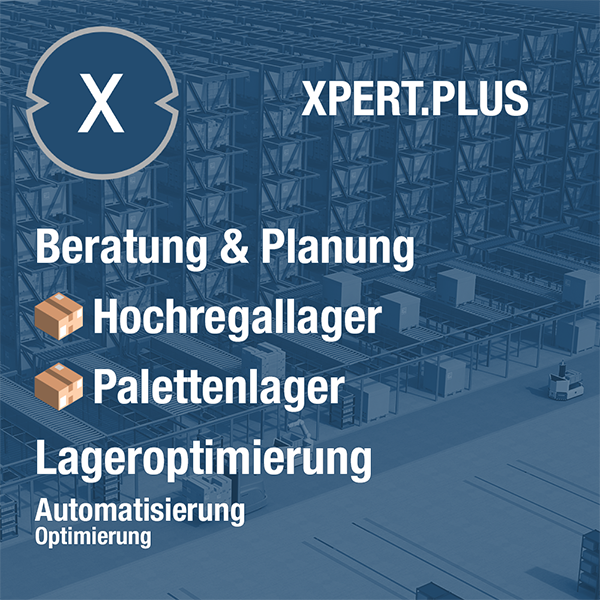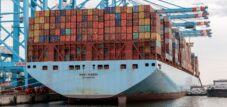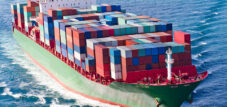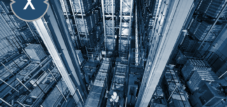Published on: July 18, 2025 / update from: July 18, 2025 – Author: Konrad Wolfenstein

Container high bearing: shelves with direct individual access instead of surrounding – creative image Xpert.digital
End with the container tetris, 90 % less space, 100 % more efficiency – the simple trick against warehouse chaos: each container a subject
What is a container plateau and what advantages does it offer?
A container plateau (also known as high-bay storage or HBS) is a fully automated warehouse system that was specially developed for the storage of standard lake containers. In contrast to conventional container yards, where containers are stacked directly on top of each other, a container plateau assigns an individual shelf to each container. This revolutionary technology enables containers to store up to a height of eleven floors without stacking them directly.
The basic innovation is that each container is accommodated on a separate shelf, which ensures direct individual access to each container. This is in stark contrast to conventional methods in which containers are stacked on top of each other and to access a lower container, all containers above it have to be stacked.
The system is based on proven high-bay warehouse technology that was originally developed for the steel industry. The SMS Group and its partner DP World have successfully transferred this technology to container terminals and realized the world's first commercial system under the name “Boxbay”.
Suitable for:
- The top ten of the container high-class bearing manufacturers and guidelines: technology, manufacturer and future of port logistics
How does the shelf operator work in a container high bearing?
The heart of a container high bearing is the shelf control units (RBG), which are responsible for the fully automatic transport of the containers. These rails guided by the alleys move between the shelf rows and can transport containers to three dimensions: horizontally along the alley, vertically up and into the depth of the shelves.
A typical shelf control device for containers is a combination of a pitched catering vehicle and a lift that is designed up to 18 tons, especially for heavy loads. The devices are equipped with telescopic forks or other specialized load computers in order to use and transport containers safely.
The operation takes place fully automatically by a warehouse management system that digitally manages every container location. With a transponder system or similar technologies, the shelf control units can precisely locate and access each container. The power supply takes place via grinding lines or energy chains, which ensures continuous operation.
What problems does the container high bearing solve?
Elimination of Shuffle-Moves
The biggest problem of conventional container yards is the so-called shuffle moves or surrounding stacking movements. These unproductive movements arise when containers are stacked on top of each other and all containers above it have to be moved to access a lower container.
In classic container yards, these unproductive movements make up between 30% and 60% of all container movements. This means that up to two thirds of all crane operations do not create productive value, but only serve to clear obstacles. With a container plan, these shuffle moves are completely omitted because every container has direct access.
Massive area savings
Container high bearing can triple the storage capacity of a terminal on the same area. While conventional container yards containers can usually only stack up to six layers, a high-bay warehouse enables the storage of up to eleven containers.
A practical example: An automated container warehouse can accommodate up to 250 containers on an area of only 950 m². With conventional storage, 9,000 m² would be required – this corresponds to a reduction in surface of 90%.
How does the efficiency differ from conventional container yards?
Increased productivity
Container high bearing show impressive performance indicators: 19.3 movements per hour and 31.8 movements per hour can be reached per hour. This high productivity arises from the elimination of ums and the possibility of controlling every container directly.
Reduced waiting times
Due to direct access to any container, truck handling times can be shortened by 20 percent. This leads to less traffic jams at the terminals and better utilization of the transport capacities. This means that 350,000 unproductive movements can be saved each year.
Energy efficiency
Container high bearings are not only more productive, but also more energy-efficient than conventional systems. With 29 percent lower energy costs and significantly reduced maintenance effort, the operating costs are below the classic container yards. The power supply can be carried out via solar cells on the system roof, which further improves sustainability.
Smart container storage – technological turn: Direct individual access changed world trade
What technical innovations enable direct individual access?
Automated control systems
The key technology for direct individual access lies in the automated control systems. These computer-supported systems manage the position of each container and can optimally coordinate transport orders. Artificial intelligence helps to predict the cheapest warehouse position for every container.
Shelf construction
The shelf construction makes it possible to store containers up to a height of 50 meters. The steel structure is dimensioned so that it can safely carry the loads of up to 50 tons per container. Each container is stored on a separate shelf, which ensures direct access.
Flexible interfaces
Container high bearings can be loaded and unloaded on different sides. An all -round transport system connects the alleys with each other and creates flexibility in the envelope. This enables various means of transport (ship, truck, truck, train) to be operated at the same time.
What are the challenges of implementation?
High investment costs
Implementation of a container high bearing requires high investment costs. The fully automatic technology, the shelf control units and the complex control software are cost -intensive to buy. However, these investments are amortized by the significantly lower operating costs and higher efficiency.
Complex planning and organization
The establishment of a container high bearing requires elaborate construction and planning. The stability and resilience of the shelf construction must be guaranteed, and integration into existing terminal structures is complex. In addition, the staff requires comprehensive training to operate the specialized shelf control units.
Technical risks
In the case of highly automated systems, there is a risk of a total failure. If the shelf operator or the control software fails, the entire storage area can be affected. Therefore, redundant systems are often implemented with several shelf operating devices per alley.
How will the container storage develop in the future?
Worldwide distribution
The first commercial container high bearing has already been successfully tested in Dubai and has processed over 63,000 container movements without major problems. In the meantime, the system is also implemented in other ports, such as in Busan, South Korea.
Modular expandability
Container high bearings are modular and fully scalable. Terminals can start with a first module and gradually expand the system as required. This also enables smaller ports to benefit from the technology without having to implement a complete solution immediately.
Integration into existing terminals
The technology can be seamlessly integrated into existing terminals. Container high bearings can be retrofitted on empty storage areas without disturbing the ongoing operation. This is particularly important for established ports that have to expand their capacity but have no space for new terminals.
What effects does this have on global logistics?
Relaxation of the supply chains
Container high bearing can make an important contribution to relaxation of global supply chain problems. Due to the higher storage capacity, terminals can hold larger buffer stocks, which makes the supply chains more robust. The shortened termination time of ships reduces traffic jams in the ports.
sustainability
The technology contributes to sustainability, since less space is used and energy consumption is lower. By reducing shuffle moves, less fuel and energy are wasted for unproductive movements. The possibility of using solar energy also improves the environmental balance.
Competitiveness of the ports
Container high bearings can significantly increase the competitiveness of ports. Ports that implement this technology can offer faster handling times and higher capacities, which makes it more attractive for shipping companies. This is particularly important because the container ships are getting bigger and need more envelope capacity.
Revolution of container logistics
Container high bearings with direct individual access represent revolutionary development in port logistics. They solve the fundamental problem of unproductive shuffle moves, which make up to 60% of all movements in conventional container yards. The storage of each container on a separate shelf enables direct access, which leads to massive increases in efficiency.
The technology not only offers business advantages such as tripled storage capacity and 20% shorter truck handling times, but also contributes to sustainability. With 29% lower energy costs and the possibility of solar energy use, it is more environmentally friendly than conventional systems.
The successful implementation in Dubai and the planned projects in other ports show that container plateau is not just a vision, but are already reality. They have the potential to transform global logistics and have to help to keep up with the growing container service and ever larger ships.
For the future of container logistics, this means a paradigm shift: away from surface-intensive, inefficient stacking systems towards highly automated, space-saving high-beam bearings with direct individual access to each container. This innovation will make a significant contribution to dealing with the challenges of global logistics and enabling more sustainable port operations.

Xpert.plus warehouse optimization – high -bay warehouse such as pallet warehouse advice and planning
Your global marketing and business development partner
☑️ Our business language is English or German
☑️ NEW: Correspondence in your national language!
I would be happy to serve you and my team as a personal advisor.
You can contact me by filling out the contact form or simply call me on +49 89 89 674 804 (Munich) . My email address is: wolfenstein ∂ xpert.digital
I'm looking forward to our joint project.













